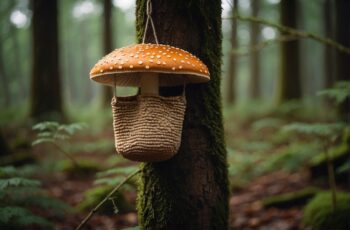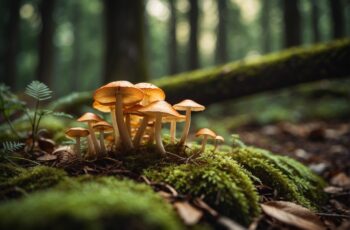Mushrooms, with their myriad varieties, are not only a fascinating subject for foragers and food enthusiasts but serve as a valuable ingredient in countless cuisines around the world. Each mushroom species thrives in its own specific season, which is influenced by factors such as temperature, humidity, and the surrounding ecosystem. Knowing the best season for mushroom hunting can greatly enhance your chances of finding the most flavorful and nutritious fungi.

To make the most of the mushroom season, you’ll want to familiarize yourself with the different types of mushrooms that might be available in your region. Whether you’re planning to enhance your diet with these nutritious fungi or intending to add depth to your culinary creations, an understanding of when specific mushrooms are at their peak can be invaluable.
Key Takeaways
- Identifying the right season is crucial for mushroom foraging.
- Different mushroom varieties offer diverse nutritional benefits.
- Cooking techniques can enhance the flavor of seasonal mushrooms.
Understanding Mushroom Varieties and Nutrition
Mushrooms offer a world of flavor and nutritional benefits, ranging from protein-rich morels to fiber-packed cremini. Knowing how to select, store, and enjoy mushrooms can boost your nutrition and culinary experiences.
Types of Edible Mushrooms
When exploring edible mushrooms, your options are vast. Cremini mushrooms are essentially baby portobellos and offer a deeper flavor than white button mushrooms, which are the most common variety found in supermarkets. For those looking to add a more exotic taste to their dishes, shiitake mushrooms possess a rich, smoky flavor, while oyster mushrooms are known for their delicate texture. Morel mushrooms are a seasonal delight with a distinctive honeycomb appearance, and porcini, with their nutty flavor, are a favorite in Italian cuisine.
Nutritional Value
Mushrooms are celebrated for their nutritional profile, being low in calories yet rich in substances your body needs. Most mushrooms contain valuable protein, fiber, vitamins, especially B vitamins, and minerals such as iron and potassium. They’re naturally low in cholesterol and sodium, which makes them a heart-healthy choice.
| Nutrient | Benefit |
|---|---|
| Protein | Supports muscle growth and repair |
| Fiber | Aids digestion and satiety |
| Vitamin B | Assists in energy production |
| Iron | Essential for blood health |
| Potassium | Helps regulate blood pressure |
Selecting and Storing Mushrooms
For the freshest experience, select mushrooms that feel firm and are free from damp spots. Store them in your refrigerator within a partially open airtight container to allow for air circulation. Wild mushrooms should be used promptly for the best flavor and texture, but some, like morels, can be dried and reconstituted with water. For longer storage, some mushrooms can also be frozen, especially if you’ll use them in cooked dishes.
Health Benefits
Mushrooms aren’t just tasty; they offer a suite of health benefits. They’re a source of vitamin D, particularly when sun-exposed, and may support immune function. Additionally, their antioxidant properties can help protect your cells from damage, and the fiber content is beneficial for maintaining a healthy digestive system.
Mushroom Seasonality
Mushroom seasonality varies, with morels typically found fresh in spring, from March to May. Remember to embrace the season with fresh finds like morels and incorporate year-round varieties such as creminis and portobellos into your dishes. Fresh wild mushrooms like chanterelles can offer up to 1200 IU of vitamin D per 3.5-ounce serving, making them a fantastic choice for boosting nutrition. If fresh options are scarce, many mushrooms are available dried, providing a convenient way to add mushrooms to your diet any time of the year.
By recognizing the types, nutritional benefits, and seasonality of mushrooms, you can enrich your diet and explore new flavors. Handle them properly to maximize their gastronomic and nutritional value. Enjoy the journey that mushrooms provide for both your palate and health.
Culinary Techniques and Mushroom Recipes
In this comprehensive guide, you’ll learn how to enhance the flavor and texture of mushrooms using various cooking techniques, find inspiration for mushroom-centered dishes, and discover flavorful pairings to elevate your culinary creations.
Preparation Methods
Before you start cooking, proper cleaning of mushrooms is essential to avoid sogginess. The best way to clean your mushrooms is by wiping them with a damp cloth or a soft brush. For tougher dirt, a quick rinse and immediate pat drying might be necessary; soaking mushrooms can cause them to absorb water and become mushy.
Mushroom Cooking Techniques
- Sautéing: For delectable sautéed mushrooms, heat olive oil and a knob of butter in a skillet over high heat. Place the mushrooms in a single layer and let them brown without stirring for 3-5 minutes, then flip and repeat. This technique enhances their natural umami and achieves a satisfying texture.
- Roasting: Roasting mushrooms in the oven with olive oil, salt, and pepper brings out a rich, concentrated flavor. Spread the mushrooms on a baking sheet in a single layer and roast at 400°F (200°C) until they’re tender with a slightly crispy edge.
- Browning: Achieving that perfect browning on mushrooms, whether you’re sautéing or roasting, is key. Use a wide pan and avoid crowding, which lets them cook evenly and develop a deep, savory flavor.
Recipe Inspirations
Peruse these mushroom recipes to inspire your next kitchen venture:
- Mushroom Pasta: Sauté mushrooms with garlic and finish with parmesan cheese and parsley for a simple yet delicious pasta topping.
- Mushroom Risotto: Cook your risotto with a mix of mushroom varieties and a dash of white wine to imbue it with earthy flavors and creamy texture.
- Baked Salmon: Top your salmon with a mushroom and herb crust for an impressive and flavor-packed main course.
Seasoning and Flavor Pairings
Mushrooms have a natural affinity for certain seasonings and flavors:
- Pair with rosemary, thyme, or tarragon for a herbaceous touch.
- Garlic butter makes an excellent base for any mushroom dish, adding depth and richness.
- For an acidic counterpoint, consider finishing with a squeeze of lemon or a splash of balsamic vinegar.
Serving Suggestions
Finally, mushrooms are incredibly versatile and can complement many dishes:
- Serve sautéed mushrooms and onions alongside steak or chicken.
- Add them to an omelet or quiche with cheese and herbs for a delightful brunch option.
- Stuffed mushrooms with breadcrumbs, cheese, and herbs are perfect appetizers.
- A simple mushroom side dish can elevate burgers, baked potatoes, or even seafood plates like shrimp scampi.
Frequently Asked Questions
Understanding the seasonality of mushrooms and the best practices for foraging can greatly enhance your ability to find and collect these natural treasures.
When do morel mushrooms typically become available for foraging?
Morel mushrooms become available in the spring, particularly from March to May. They commonly grow in wooded areas and near dying trees.
What times of day are most ideal for mushroom hunting?
The most ideal times for mushroom hunting are during the early morning and just after rain when humidity is higher, aiding mushroom growth.
In what season do fall mushrooms usually start to appear?
Fall mushrooms generally start to appear in late summer to early autumn, with many species flourishing as the forest floor becomes moist and temperatures drop.
Are there peak months for foraging wild mushrooms in the Pacific Northwest?
The peak months for foraging wild mushrooms in the Pacific Northwest are typically from September to November, with variations depending on the specific mushroom species.
What variety of mushrooms can be found during the current season in Oregon?
During the current season in Oregon, you can find a selection that includes chanterelles, porcinis, and hedgehog mushrooms, among others.
How does the climate in California affect the mushroom foraging season there?
The diverse climate in California results in a year-round foraging season, but the coastal regions often yield the best results during the fall through the winter months.


